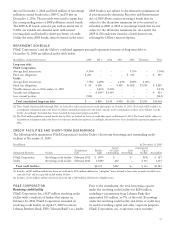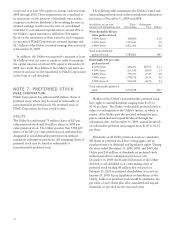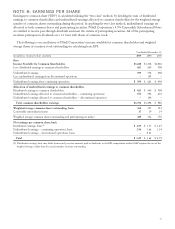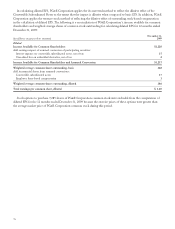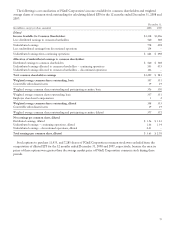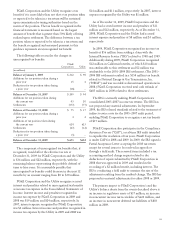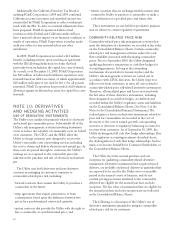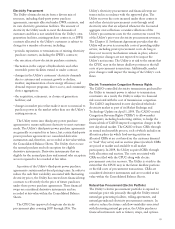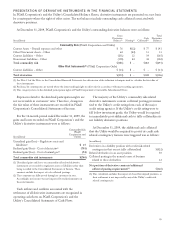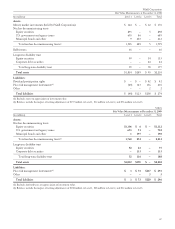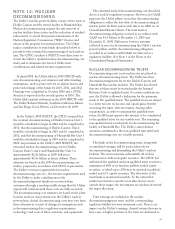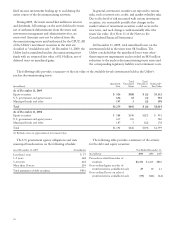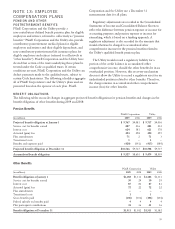PG&E 2009 Annual Report Download - page 87
Download and view the complete annual report
Please find page 87 of the 2009 PG&E annual report below. You can navigate through the pages in the report by either clicking on the pages listed below, or by using the keyword search tool below to find specific information within the annual report.Electricity Procurement
The Utility obtains electricity from a diverse mix of
resources, including third-party power purchase
agreements, amounts allocated under DWR contracts, and
its own electricity generation facilities. The amount of
electricity the Utility needs to meet the demands of
customers and that is not satisfied from the Utility’s own
generation facilities, existing purchase contracts, or DWR
contracts allocated to the Utility’s customers is subject to
change for a number of reasons, including:
• periodic expirations or terminations of existing electricity
purchase contracts, including the DWR’s contracts;
• the execution of new electricity purchase contracts;
• fluctuation in the output of hydroelectric and other
renewable power facilities owned or under contract;
• changes in the Utility’s customers’ electricity demands
due to customer and economic growth or decline,
weather, implementation of new energy efficiency and
demand response programs, direct access, and community
choice aggregation;
• the acquisition, retirement, or closure of generation
facilities; and
• changes in market prices that make it more economical to
purchase power in the market rather than use the Utility’s
existing resources.
The Utility enters into third-party power purchase
agreements to ensure sufficient electricity to meet customer
needs. The Utility’s third-party power purchase agreements
are generally accounted for as leases, but certain third-party
power purchase agreements are considered derivative
instruments and, therefore, are recorded at fair value within
the Consolidated Balance Sheets. The Utility elects to use
the normal purchase and sale exception for eligible
derivative instruments. Derivative instruments that are
eligible for the normal purchase and normal sales exception
are not required to be recorded at fair value.
A portion of the Utility’s third-party power purchase
agreements contain market-based pricing terms. In order to
reduce the cash flow variability associated with fluctuating
electricity prices, the Utility has entered into financial swap
contracts to effectively fix the price of future purchases
under those power purchase agreements. These financial
swaps are considered derivative instruments and are
recorded at fair value within the Consolidated Balance
Sheets.
The CPUC has approved a long-term electricity
procurement plan covering 2007 through 2016. The
Utility’s electricity procurement and financial swaps are
transacted in accordance with the approved plan. The
Utility recovers the costs incurred under these contracts
and other electricity procurement costs through retail
electricity rates that are adjusted whenever the forecasted
aggregate over-collections or under-collections of the
Utility’s procurement costs for the current year exceed 5%
of the Utility’s prior year electricity procurement revenues.
The Chapter 11 Settlement Agreement provides that the
Utility will recover its reasonable costs of providing utility
service, including power procurement costs. As long as
these cost recovery mechanisms remain in place, adverse
market price changes are not expected to impact the
Utility’s net income. The Utility is at risk to the extent that
the CPUC may in the future disallow portions or the full
costs of procurement transactions. Additionally, market
price changes could impact the timing of the Utility’s cash
flows.
Electric Transmission Congestion Revenue Rights
The CAISO-controlled electricity transmission grid used by
the Utility to transmit power is subject to transmission
constraints. As a result, the Utility is subject to financial
risk associated with the cost of transmission congestion.
The CAISO implemented its new day-ahead wholesale
electricity market as part of its Market Redesign and
Technology Update on April 1, 2009. The CAISO created
Congestion Revenue Rights (“CRRs”) to allow market
participants, including load-serving entities, to hedge the
financial risk of CAISO-imposed congestion charges in the
new day-ahead market. The CAISO releases CRRs through
an annual and monthly process, each of which includes an
allocation phase (in which load-serving entities are
allocated CRRs at no cost based on the customer demand
or “load” they serve) and an auction phase (in which CRRs
are priced at market and available to all market
participants). In 2009, the Utility acquired CRRs through
both allocation and auction. The costs associated with
CRRs are filed with the CPUC along with electric
procurement costs for recovery. The Utility is at risk to the
extent that the CPUC may in the future disallow portions
or the full costs of procurement transactions. CRRs are
considered derivative instruments and are recorded at fair
value within the Consolidated Balance Sheets.
Natural Gas Procurement (Electric Portfolio)
The Utility’s electric procurement portfolio is exposed to
natural gas price risk primarily through the Utility-owned
natural gas generating facilities, tolling agreements, and
natural gas-indexed electricity procurement contracts. In
order to reduce the future cash flow variability associated
with fluctuating natural gas prices, the Utility purchases
financial instruments such as futures, swaps, and options.
83


